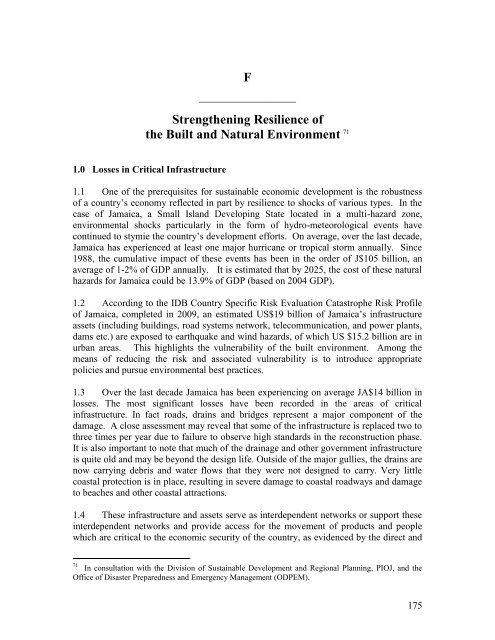PIOJ Growth-Inducement Strategy - Planning Institute of Jamaica
PIOJ Growth-Inducement Strategy - Planning Institute of Jamaica
PIOJ Growth-Inducement Strategy - Planning Institute of Jamaica
You also want an ePaper? Increase the reach of your titles
YUMPU automatically turns print PDFs into web optimized ePapers that Google loves.
F<br />
____________________<br />
Strengthening Resilience <strong>of</strong><br />
the Built and Natural Environment 71<br />
1.0 Losses in Critical Infrastructure<br />
1.1 One <strong>of</strong> the prerequisites for sustainable economic development is the robustness<br />
<strong>of</strong> a country’s economy reflected in part by resilience to shocks <strong>of</strong> various types. In the<br />
case <strong>of</strong> <strong>Jamaica</strong>, a Small Island Developing State located in a multi-hazard zone,<br />
environmental shocks particularly in the form <strong>of</strong> hydro-meteorological events have<br />
continued to stymie the country’s development efforts. On average, over the last decade,<br />
<strong>Jamaica</strong> has experienced at least one major hurricane or tropical storm annually. Since<br />
1988, the cumulative impact <strong>of</strong> these events has been in the order <strong>of</strong> J$105 billion, an<br />
average <strong>of</strong> 1-2% <strong>of</strong> GDP annually. It is estimated that by 2025, the cost <strong>of</strong> these natural<br />
hazards for <strong>Jamaica</strong> could be 13.9% <strong>of</strong> GDP (based on 2004 GDP).<br />
1.2 According to the IDB Country Specific Risk Evaluation Catastrophe Risk Pr<strong>of</strong>ile<br />
<strong>of</strong> <strong>Jamaica</strong>, completed in 2009, an estimated US$19 billion <strong>of</strong> <strong>Jamaica</strong>’s infrastructure<br />
assets (including buildings, road systems network, telecommunication, and power plants,<br />
dams etc.) are exposed to earthquake and wind hazards, <strong>of</strong> which US $15.2 billion are in<br />
urban areas. This highlights the vulnerability <strong>of</strong> the built environment. Among the<br />
means <strong>of</strong> reducing the risk and associated vulnerability is to introduce appropriate<br />
policies and pursue environmental best practices.<br />
1.3 Over the last decade <strong>Jamaica</strong> has been experiencing on average JA$14 billion in<br />
losses. The most significant losses have been recorded in the areas <strong>of</strong> critical<br />
infrastructure. In fact roads, drains and bridges represent a major component <strong>of</strong> the<br />
damage. A close assessment may reveal that some <strong>of</strong> the infrastructure is replaced two to<br />
three times per year due to failure to observe high standards in the reconstruction phase.<br />
It is also important to note that much <strong>of</strong> the drainage and other government infrastructure<br />
is quite old and may be beyond the design life. Outside <strong>of</strong> the major gullies, the drains are<br />
now carrying debris and water flows that they were not designed to carry. Very little<br />
coastal protection is in place, resulting in severe damage to coastal roadways and damage<br />
to beaches and other coastal attractions.<br />
1.4 These infrastructure and assets serve as interdependent networks or support these<br />
interdependent networks and provide access for the movement <strong>of</strong> products and people<br />
which are critical to the economic security <strong>of</strong> the country, as evidenced by the direct and<br />
71<br />
In consultation with the Division <strong>of</strong> Sustainable Development and Regional <strong>Planning</strong>, <strong>PIOJ</strong>, and the<br />
Office <strong>of</strong> Disaster Preparedness and Emergency Management (ODPEM).<br />
175
















